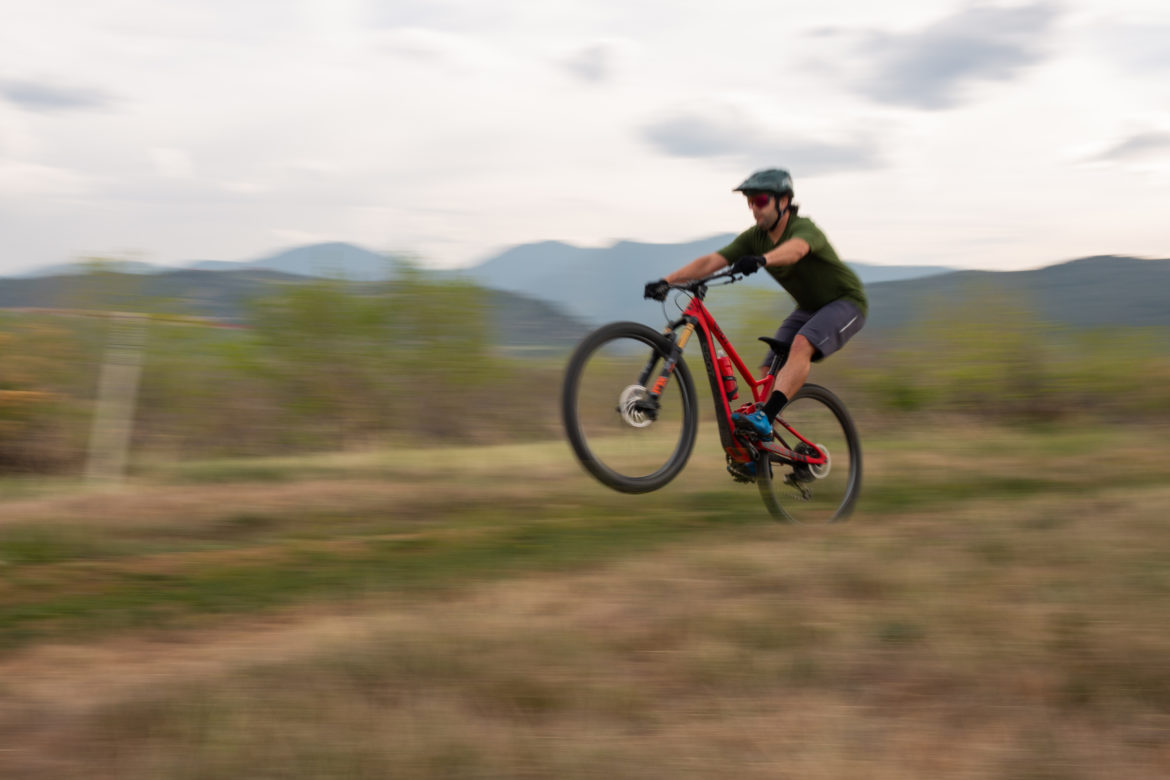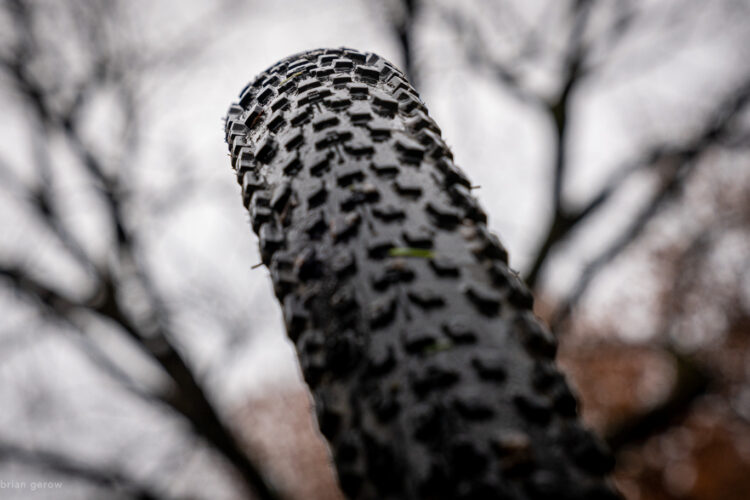
Last year, Spot Bikes, the boutique brand out of Golden, Colorado debuted two new cross-country bikes at Sea Otter: the Ryve and Ryve 115. Both are cross-country bikes, the Ryve with 100mm of travel, and the 115 with a little bit more. Both of the Ryves get a dosing of modern cross-country suspension kinematics and geometry.
The past year or so has been huge for XC bikes, crossing over into a more trail-capable category, and that trend doesn’t look like it’s slowing down. The bike industry and consumers alike are rediscovering that short-travel bikes can be designed to descend better than ever. Not only can they outclimb bikes in other categories, but with the right geometry, these light-duty trail rigs are just as fun when they’re pointed downhill.
About the Ryve 115

Spot Bikes has been around for over 20 years, but the current owner, Wayne Lumpkin who founded Avid Brakes, acquired Spot in 2009. Lumpkin’s son, Andrew, runs Spot as the CEO. With the change, Spot focused on belt drive bikes for a while at first, but seven years after the change of hands, Spot launched its first full suspension mountain bike, the Rollik, a 150mm 27.5-inch bike, in 2016.
A year later, again right around the 2017 Sea Otter, Spot released the Mayhem. The brand was on a roll, and now had a solid, 130mm 29er trail bike in the lineup. They have had some sort of update or new release every April since the Rollik. Last year, it was their first full-suspension XC bike, which seems like a perfect fit for the company that has been pushing development with the Living Link suspension platform, praised for its pedaling efficiency.
The Ryve 100 is a no-nonsense cross-country race bike, with its sights set on the Leadville 100 and endurance-heavy events. The front travel is matched with a 100mm Fox 32 Step-Cast fork, and other XC accents, like Stan’s Crest wheels, SRAM Level brakes, and ENVE M6 handlebars, and 2.25″ Schwalbe tires front and rear.
Geometry on the Ryve 100 is progressive for an XC rocket though. On a size medium, there is a 75.7° effective seat tube angle, a 68.4° head tube angle, a 1157mm wheelbase, and a long-for-XC 453mm reach. The standover height is also rather short at 705mm.
The differences on the Ryve 115 make the bike more adept at everyday trail use. There’s over an additional half-inch of rear travel, with a 120mm Fox 34 Step-Cast fork up front. The tire choice is still on the lighter side, but with a 2.35-inch-wide Schwalbe Nobby Nic up front.
Geometry is a little more aggressive and relaxed. The Ryve 115 has a 75° seat tube angle, and a 67.4° head tube angle, neither of which is unreasonable for a 120mm trail bike these days. The wheelbase is slightly longer at 1167mm on a size medium, and the chainstays are the same 435mm.
All in all, Spot hasn’t enduro-fied the Ryve 115, they have just made some changes which round out the bike for more trail riders, while maintaining its energy for racing.
About the Living Link

The Living Link suspension is truly unique from many other platforms. While dual-link suspension platforms are common on bikes from brands like Ibis and Pivot with DW-Link, or the Banshee KS suspension, Spot has made a big departure from the norm. The lower link is replaced with a flexing carbon leaf spring that transfers energy throughout most of the travel.
When the suspension is compressed, the leaf spring flexes, and when the rear triangle gets about halfway through its travel, the spring is at its maximum amount of flex. At full suspension compression, the leaf spring relaxes again. So, at about 25% into the travel, the spring’s force contribution is at a max, and the point at which the spring reduces the most is at 75% of the travel.

“The result is a spring contribution to the suspension system,” says Spot. “Consider it a boost of superpower when you most need it on long technical climbs.” Spot says that the design also makes the suspension more efficient, enhancing — or flattening — the spring curve in the middle of its travel, where the bike will spend most of its time. This makes the suspension more responsive in its mid-stroke.
The design also replaces a set of bearings on the rear triangle, because the leaf spring bolts directly to a bridge between the chainstays from a pivot on the seat tube. Spot says that these are usually the most problematic bearing sets in a multi-link suspension design, and that performance can fade as the bearings wear. Spot has tested the durability through three million flex cycles without failure, which they have equated to riding seven days a week for 12 years.
On the trail

So, there I was. Just starting out on a ledgy portion of the Ponderosa trail at Three Sisters in Evergreen. It’s one of those sections where as soon as you clear your front tire, you have to get up to unweight the rear, and then move your weight back to the rear again to get the front tire up another step. Except, I had completely botched it, and I was locked into a standstill, staring at the rock in front of me, trackstanding on the Ryve 115. I should have tipped to one side, or lost all of my momentum and restarted the segment, but as I was in my trackstand, I thought, “Well, I guess I’ll try pedaling again.” And, as easily as pushing on the gas in a car, I just pedaled my way out of the awkward position.
There is a lot of talk in bike reviews about how forgiving bikes are downhill, how they mute the trail underneath us, and let us get away with really poor line choices at stupid speeds. The Spot Ryve 115 is that bike, but instead, it happens on the climbs. It is a forgiving uphill bike and it’s one of the best climbing platforms I have ridden yet.

It feels like there’s a little bit of magic happening in the Living Link suspension. Pedal bob is not noticeable, and there is a lot of pep in the Ryve’s step, whether it’s uphill, or on the flats. This XC bike encourages pedaling anywhere, with responsive pedaling feedback and tires that claw at the trail ahead. It doesn’t hurt that my test bike, the 5-star build in a medium, weighed 26lbs without pedals.
But, it’s not just that the Ryve’s suspension is tight and efficient, it still feels like it keeps great traction in most places. The only place I started to lose some, was out of the saddle, climbing up rocky or steep sections, which is to be expected, although the Ryve didn’t feel perfect here. In the saddle though, the traction feels unmatched, and the suspension never felt bogged down or stuck climbing up technical features. It feels like the opposite, and that springy thingy Spot is talking about feels like it’s hard at work, almost helping build to momentum to get the rear wheel over obstacles.

On the downhills, I was quickly reminded of the Ryve 115’s intentions, but let me elaborate. The 115 is capable heading downhill, but on the flipside, it isn’t all that forgiving. On repetitive hits through chunky trail, I was reminded to reel it back in a little, and that I need to be more careful with my line choice than if I was on a mid-travel bike, more raked out.
The Ryve’s head angle, at 67.4° strikes a balance between aggressive and responsive. With the 1167mm wheelbase, the bike still feels bred for cross-country racing, when low speed handling and maneuverability are a priority. This makes it a breeze for hammering up or down everyday trails and switchbacks, but it also feels plenty stable at speed.
And, the Ryve has a lot of personality. I was surprised at how eager it is to jump, or pop into a manual. Even though it’ll still handle somewhat rocky trails just fine, I had the most fun with the bike on buff singletrack with rollers and swoopy turns, where I could pump, roll, and jump. The suspension easily ramps up for takeoff, but again, with 115mm of travel, it doesn’t feel like the most plush landing on jumps or drops.

Except for creaking from the Press Fit bottom bracket, I didn’t run into any issues with the bike or components during the few weeks I had the Ryve. I was reminded how much of a difference wider tires can make though, as a 2.25/2.35″ setup is narrower than what I’ve ridden in a while. The width doesn’t feel out of place on the Ryve 115, but a touch wider probably wouldn’t hurt either. Aside from having the most annoying reach adjust out there, the SRAM Level TLMs with a 180mm rotor up front felt like plenty of power for this bike.
The ENVE M6 handlebars and BikeYoke Revive were a nice touch, especially for the price point, although on a medium, a 150mm post would be nice.
For the price though, $5,600 feels like a pretty solid deal for the 5-star build Ryve, especially considering it’s a full carbon frame, with well-designed suspension platform, Fox Factory suspension with Kashima, and it weighs 26lbs. Comparable bikes, like the Yeti SB100 or the Pivot Mach 4 SL don’t match the componentry that the Spot Ryve delivers at the price point.
Closing thoughts

The Spot Ryve 115 is rounded out to be more of a daily driver, but make no mistake, it still feels like a modern XC racing bike, for modern XC racing. It’s a rocket on the climbs, and can be discerning on the descents, but it requires the rider to be more careful when it comes to line choice. Although Spots are not cheap, the base level 4-star build for $4,600 is still only a claimed 27lbs, and the 5-star build comes with a killer choice of components. For riders who want something they can throw on the line during weekends, or the occasional stage race, and need a bike that will pull double duty as their daily driver, the Spot Ryve 115 will certainly not disappoint.
⭐️ Find the Spot Ryve 115 at Spot Bikes.





















